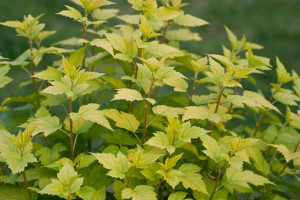Ninebark offers 4 seasons of interest
 Ninebark (Physocarpus) is a lovely, low-input, flowering shrub. What do I mean by input? Well, let’s start with how it relates to you. The shrubs needs little maintenance – or input – on your part. Sweet! Secondly, it needs little input in regards to water, fertilizer or pesticides. Double sweet! The only high input category it falls into is how prized it is by bees and butterflies for its nectar and pollen. Triple sweet – home run!
Ninebark (Physocarpus) is a lovely, low-input, flowering shrub. What do I mean by input? Well, let’s start with how it relates to you. The shrubs needs little maintenance – or input – on your part. Sweet! Secondly, it needs little input in regards to water, fertilizer or pesticides. Double sweet! The only high input category it falls into is how prized it is by bees and butterflies for its nectar and pollen. Triple sweet – home run!
Physocarpus opufolius, native to much of Eastern North America, is the source for many common cultivars used in landscapes. Most ninebark have a graceful, vase-shaped habit. Foliage can be green, burgundy-brown, golden or amber. Button-shaped white or pinkish-white flowers appear in later spring and early summer. The flower buds are set on old wood, so if pruning is required, do so right after they finish blooming. Some popular selections include ‘Summer Wine’ (pictured) that has chocolate leaves and grows to four to five feet tall.
 ‘Nugget’ (photo courtesy of Spring Meadow Nursery) features shimming golden to lime green leaves and tops out between three and five feet.
‘Nugget’ (photo courtesy of Spring Meadow Nursery) features shimming golden to lime green leaves and tops out between three and five feet.

Another attraction of ninebark is their exfoliating bark, the reason for the common name suggesting nine layers of bark. The inner bark is a pleasing coppery-brown to reddish color. Ninebarks enjoy sun to part shade and are hardy in Zones 2 to 8.
Pictured below are some additional superstars!
(If you like my blogs, please sign up for my info-packed monthly newsletters here. Also like Perennially Yours on Facebook.
Proven Winners ‘Tiny Wine’
‘Center Glow’ (photo Bailey Nurseries)
‘Diabolo’ with Sumac ‘Tiger Eyes’ (photo Bailey Nurseries)



